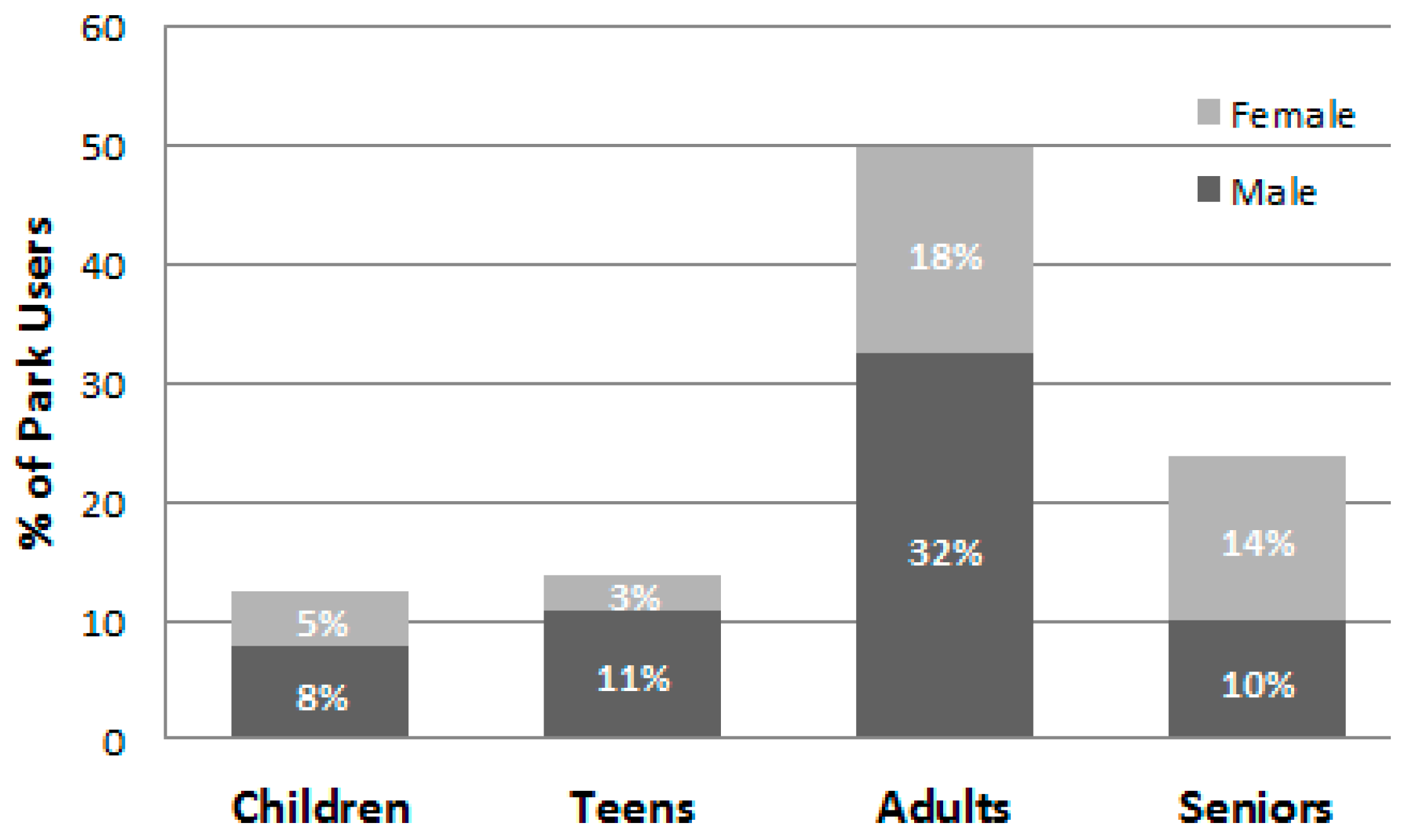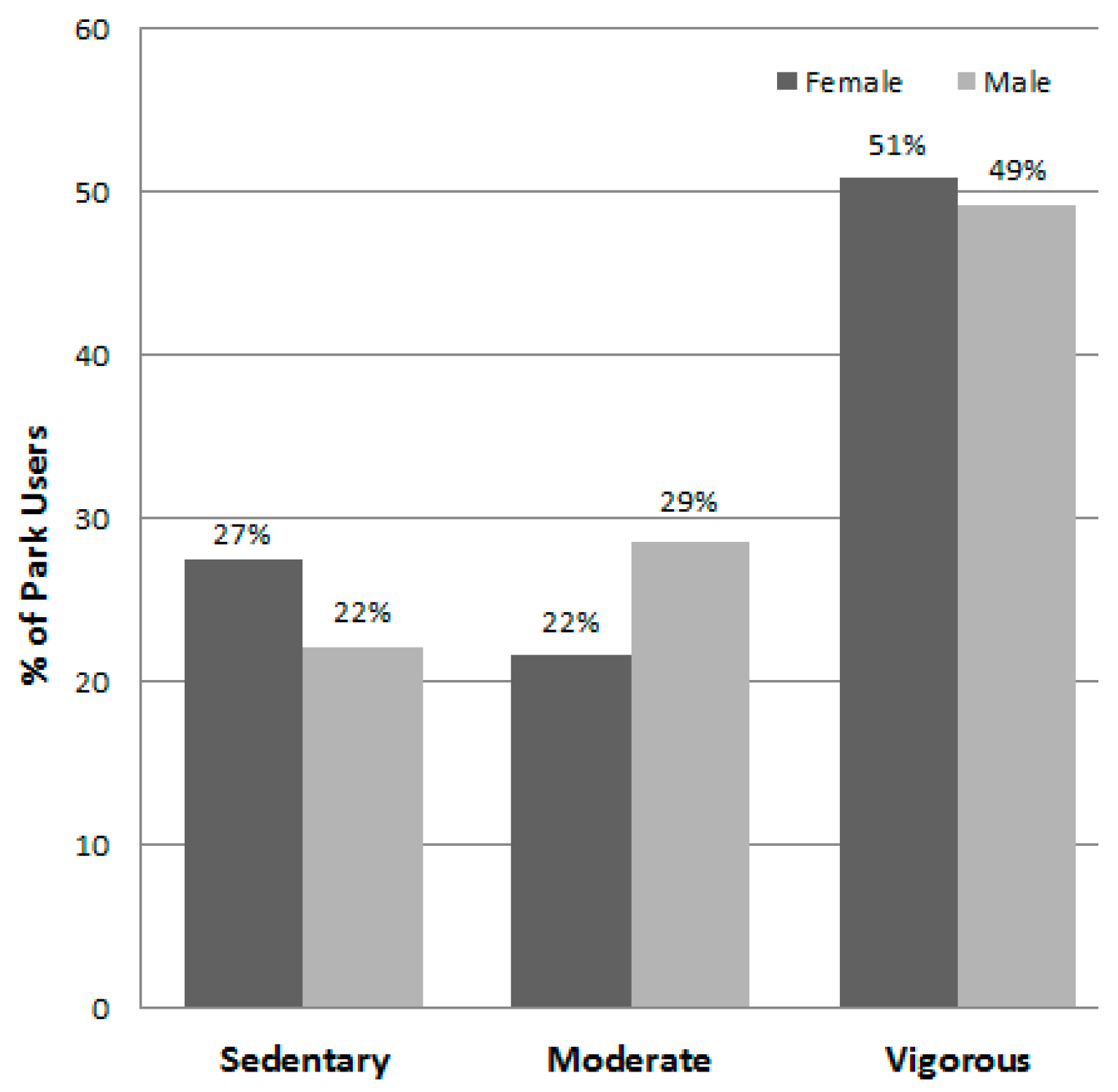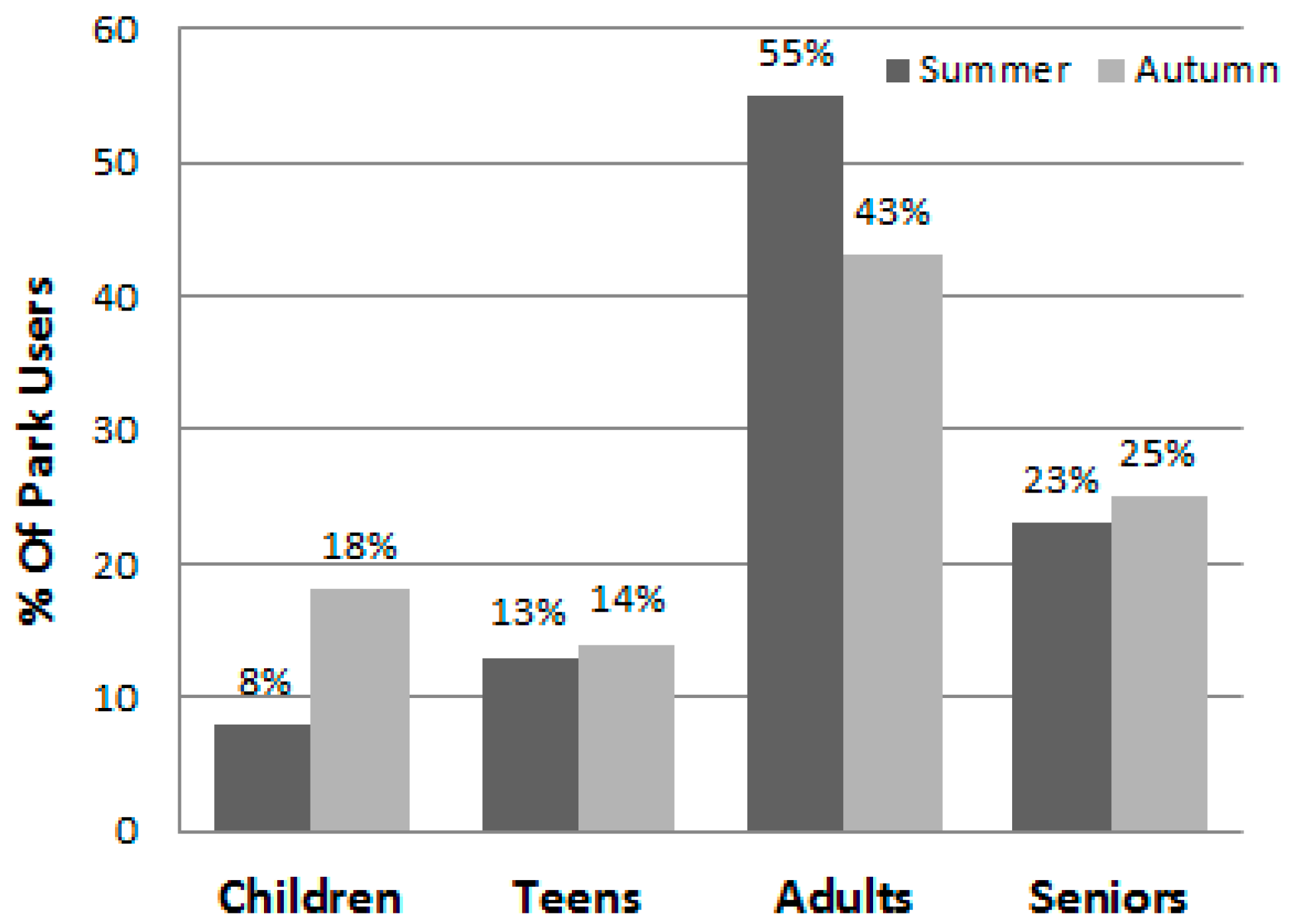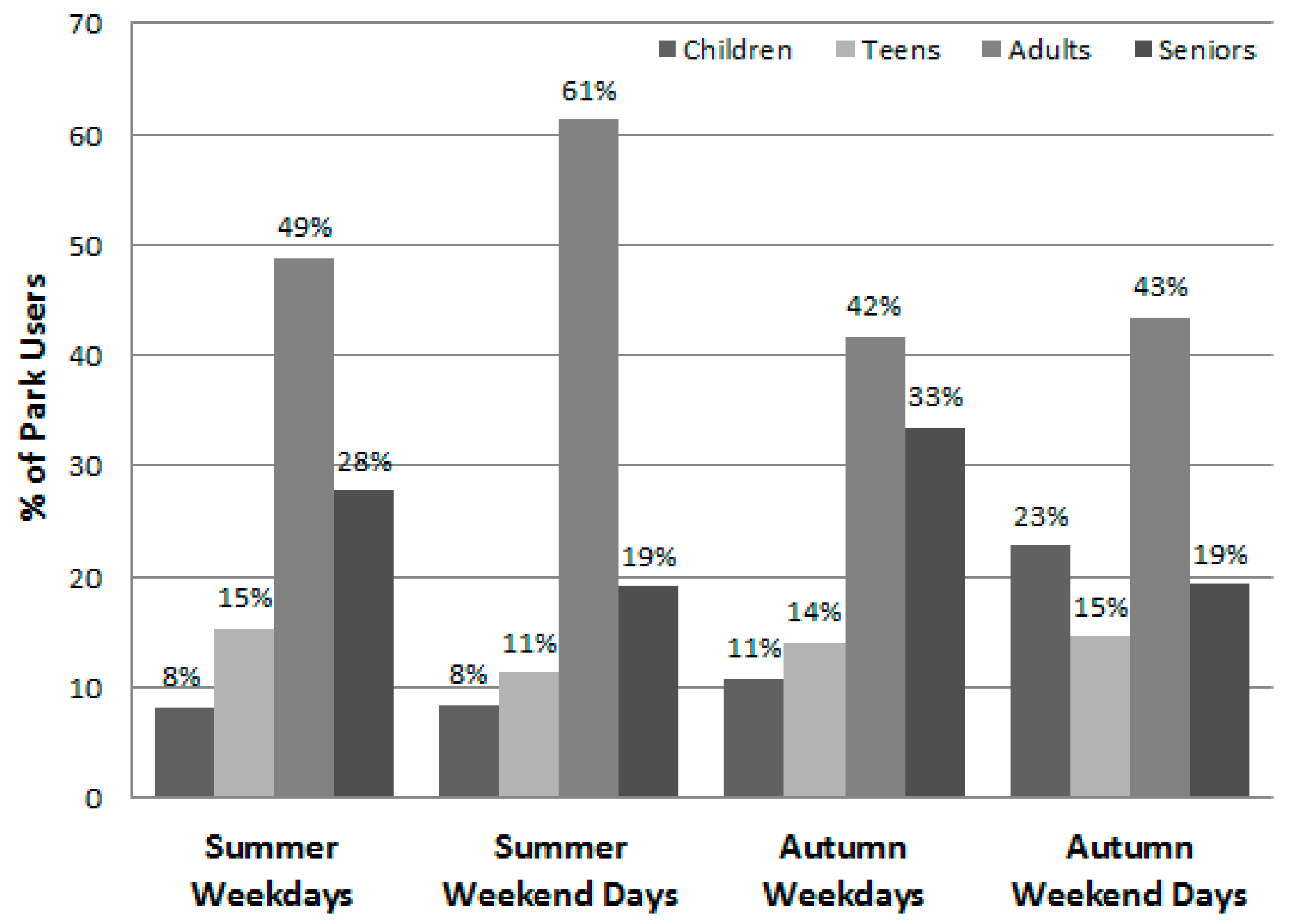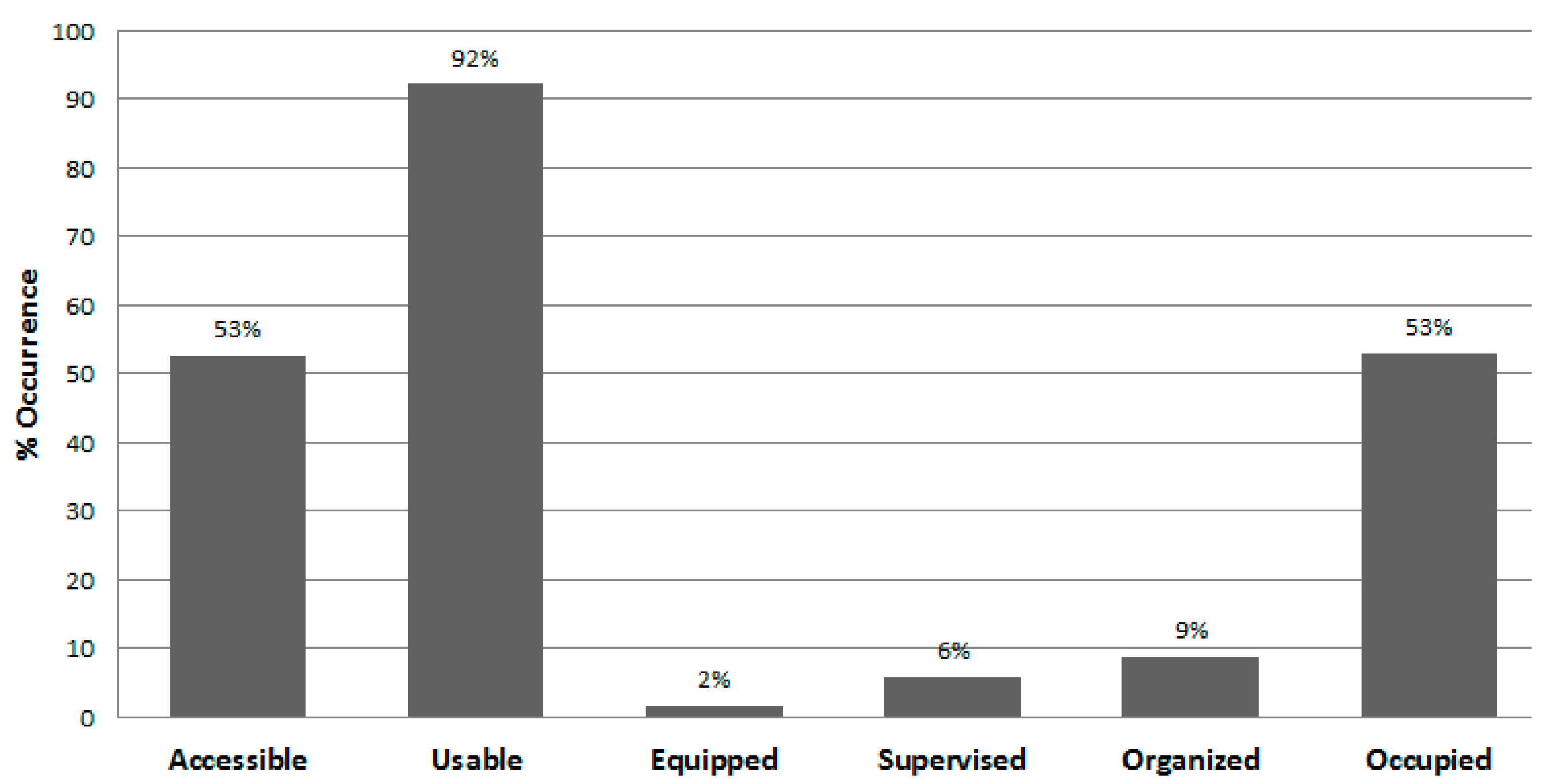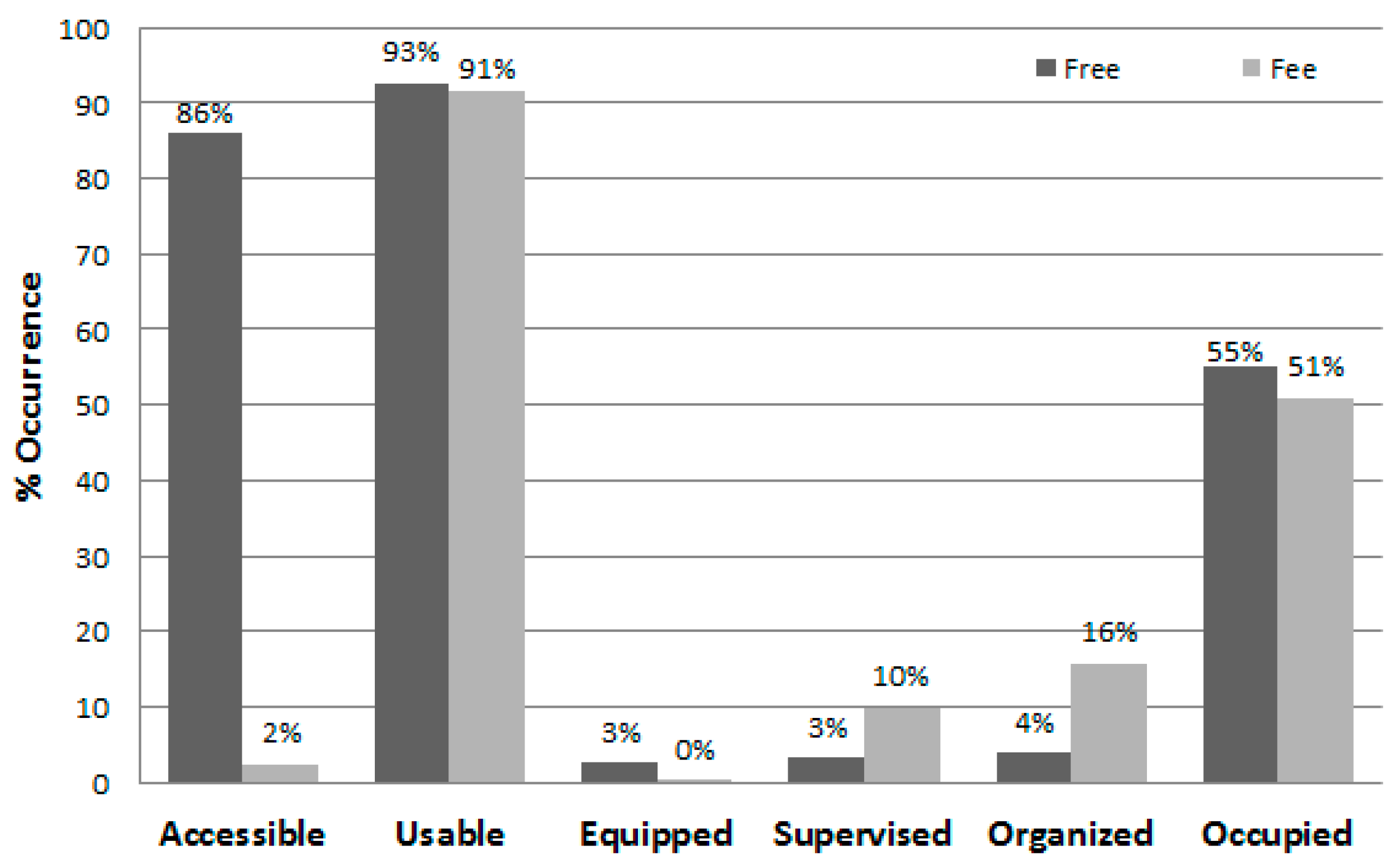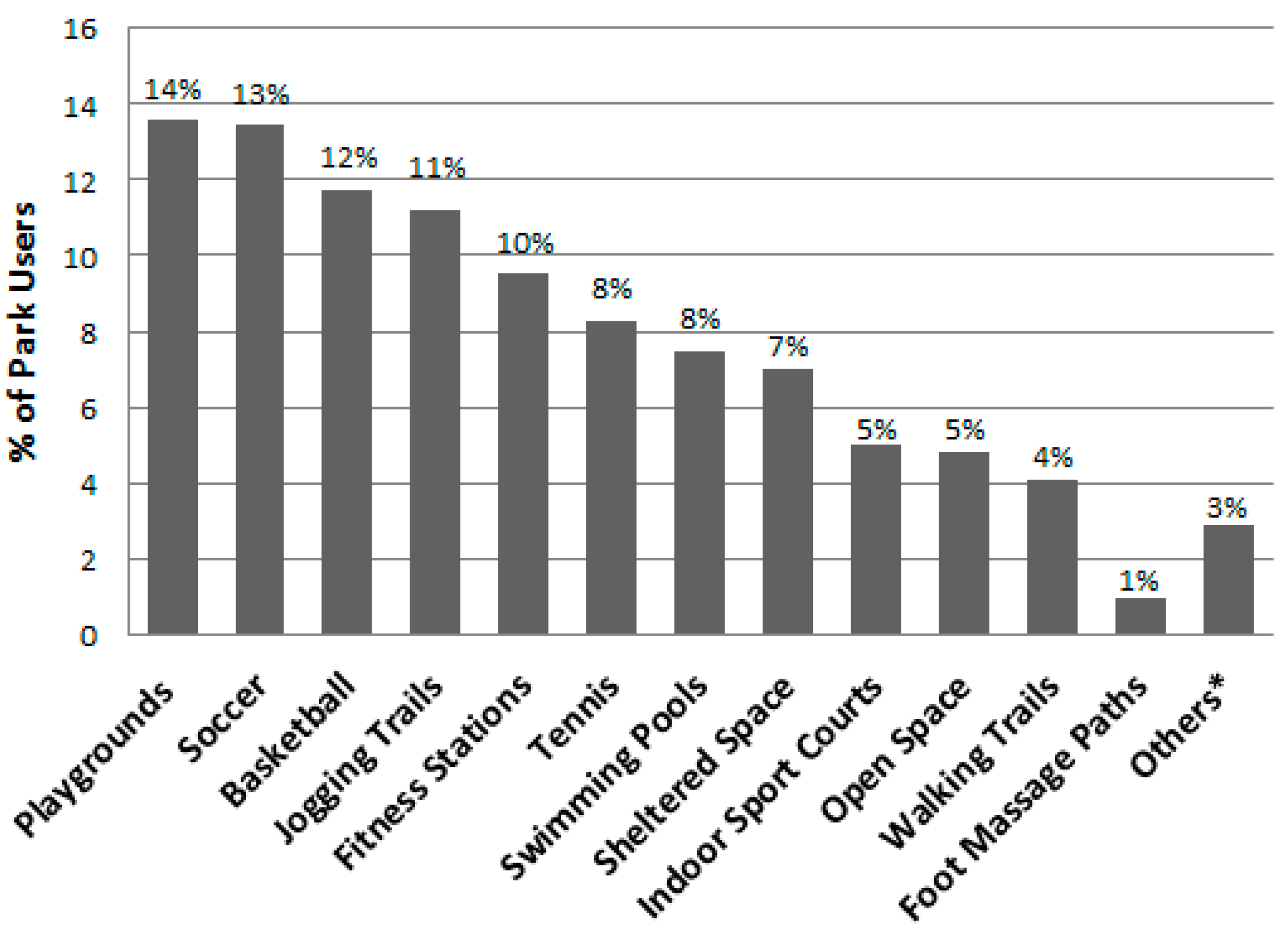1. Introduction
The built environment, including parks, plays a key role in public health [
1,
2,
3,
4]. In addition to providing opportunities for people to be outdoors where they can socialize and receive the benefits of fresh air and sunshine, parks provide opportunities for people to participate in health-related physical activity (PA). Engaging in PA regularly is important in the reduction in risk of numerous chronic diseases and to promote mental and psychological wellbeing and is important for people of all ages [
5]. The
2008 United States Physical Activity Guidelines [
6], for example, recommend that children and adolescents engage in at least 60 min of mostly moderate-to-vigorous physical activity (MVPA) daily and the World Health Organization (WHO) [
7] recommends that adults aged 18–64 participate in at least 150 min of moderate-intensity PA or 75 min of vigorous-intensity PA (or some combination) weekly.
Parks that are accessible to the public regardless of age or income are particularly important in urban areas, especially in high-density cities. Public parks are especially valuable because they offer no- or low-cost programs, are typically open throughout the day, and are designed with recreation facilities that support leisure-time physical activity [
8,
9]. The frequency of park use and the activities that people do in them vary substantially, and these are associated with numerous factors, including population density, people’s perceptions of safety, and park size, facilities, amenities, programming, and staffing [
8,
10,
11,
12,
13,
14,
15].
Parks are of different sizes, and they also have diverse spaces, facilities, and features that may attract people with different characteristics (e.g., gender, age) [
11,
12,
13,
14,
15]. For example, the National Study of Neighborhood Parks (NSNP), a direct observation investigation of 174 neighborhood parks in 25 randomly selected U.S. cities with a population over 100,000 people found parks disproportionately used by males, children, and teens while being underutilized by adults, especially seniors [
11]. Park size matters, and the NSNP study found that relative park size independently contributed to about 10% of the use of these neighborhood parks. Population density and the number of facilities were also strong predictors of park use, with smaller parks tending to have more users per acre [
11].
Numerous areas and facilities (e.g., sports fields/courts, exercise stations, walking paths) are designed specifically to engage park users in moderate and vigorous physical activity (MVPA) [
16]. Other spaces, such as picnic areas, are more conducive to sedentary activities such as relaxing and socializing. Few evaluations have directly measured specific facility use and documented the degree to which they enhance park use and physical activity [
10,
13,
15,
16]. Documenting the association between types of facilities and physical activity in parks can provide information that is useful for building or redesigning parks so that they can best promote population PA. This is particularly important when considering the value of parks to a community relative to the costs of building and maintaining specific facilities [
17].
Seasonality is another important consideration in park use and design [
10,
18]. Not only do weather conditions affect facility use (e.g., outdoor swimming pools), but some sports have traditional “seasons” that attract different numbers and types of participants, including spectators, to specific park areas at different time periods. Finding out how park areas attract various users at different times of the year could potentially influence park design, staffing, and programming in a way that could lead to greater population-level PA.
While PA can be measured in many different ways, systematic observation excels in being able to provide contextually-rich information on the setting in which activity occurs [
19]. Direct observation has the advantages of flexibility, high internal validity, low inference, and low subject burden and is particularly useful for determining how PA is influenced by the immediate environment. During the past decade the System for Observing Physical Activity in Communities (SOPARC) was developed and evaluated [
18,
20] and is becoming a widely used indicator of park use [
10,
11]. SOPARC assesses park area users’ PA levels, gender, activity modes/types, and apparent age groupings while simultaneously providing contextual information on the activity area (i.e., accessibility, usability, and levels of supervision and organization). With multiple observations, SOPARC can provide a valid measure of weekly park use and activity levels [
11]. Evenson and colleagues [
10] recently reviewed 24 cross-sectional studies that used SOPARC and reported that most of the studies were conducted in the USA and during a single season only. The review indicated that the activity levels of park users varied greatly across studies, with youths generally being more physically active than adults and younger children being more active than adolescents. In addition to these cross-sectional studies, SOPARC has been used to assess a variety of interventions including the implementation of community fitness programs [
21], modifying policies and programming [
17] and adding fitness zones [
22] and smaller pocket parks [
23].
Our review of the literature located only two studies that used SOPARC to assess physical activity and park use in Asian countries, one in Nanching, China [
24] and the other in Taipai, Taiwan [
25]. Direct observations of park use in Hong Kong, a large metropolitan area that has many residents leading sedentary lifestyles, have not been reported. Hong Kong has approximately 7.3 million residents; and with a land population density of 6690 persons/km
2 in 2014 is one of the most densely populated cities in the world and has a large proportion of citizens living in high-rise buildings. A recent Behavioral Risk Factor Surveillance System Report [
26] indicated that over three-fifths (62.5%) of Hong Kong adults did not reach WHO recommended physical activity levels [
7].
In addition to having numerous small parks without sports facilities and gardens that cater to more sedentary activities, Hong Kong has 30 urban public parks that are managed by the government Leisure and Cultural Services Department that include at least one outdoor sports facility and one children’s playground. The degree to which these urban parks and their diverse physical activity facilities are used by males and females and by different age groups has not been examined. We used SOPARC methods to objectively quantify the characteristics of the users (e.g., gender, age grouping, physical activity levels) of 262 specific PA areas in nine of the public parks in Hong Kong. To determine potential seasonal influence, we conducted observations in the same parks during both summer (June, July) and autumn (October, November). In addition to providing information useful to Hong Kong administrators for future planning of park facilities and establishing priorities to promote physical activity, the results of the investigation provide a baseline for comparison by other large, high-density cities in Asia and beyond.
4. Discussion
Data for this first-ever surveillance study of nine public parks in Hong Kong were obtained using a validated and widely-used systematic observation instrument during summer and autumn seasons (total of 288 park observation sessions during 72 days, including 36 weekdays and 36 weekend days). A total of 28,585 park visitors in 262 diverse areas, including 2144 swimming pool users, were assessed. The parks were widely used throughout the day on both weekdays and weekend days, with an average of 99 people seen during any single observation period that took less than an hour. The observed mean 367 of visitors per park (range = 131 to 587) during four observation sessions per day is more than the 305 observed in a study of 50 parks in Los Angeles parks [
31] and far greater than those in other studies [
10,
11,
32]. Located in density populated areas and within a 15 min walk from at least one large residential area, the visitor rates of these Hong Kong parks were above the 88th percentile of parks in 24 other studies that also used SOPARC [
10].
Park size matters. Larger parks, which also had more activity areas, attracted more visitors during the observed periods (small: 3133; medium: 9218; large: 14,090). The exception was Park #3, a large park that had fewer visitors than the medium size parks. Park #3 is located near the center of a relatively large new town in a district with a population density lower than other observed areas. In addition to this large park, the town also has many other smaller green park spaces spread throughout the area.
A large proportion of the visitors (71%) to the nine parks were adults and seniors, a sharp contrast with the findings of most other studies where teens and children are the typical users [
10]. Of special note is the high proportion of visitors who were seniors (25%), especially when compared to the proportion (19.1%) identified in the 2011 Hong Kong population census and to studies that report seniors to be from only 4% [
11] to 11% [
21] of park users. One exception is an intervention study of green spaces in Taipei, Taiwan that specifically targeted seniors; it reported that 61% of the park users were seniors [
25]. It may be that Hong Kong, and possibly other Asian cities, pay specific attention to the welfare of seniors who may have more ambulatory challenges than young people. For example, the Government of Hong Kong Special Administrative Region, which provides guidelines and standards for both passive and active recreation areas, has a specific section governing recreation facilities for the elderly [
33]. Eight of the nine parks in the current study had a fitness station area designed specifically for seniors. This explicit attention is important, because seniors, if retired, have increased leisure time and may be attracted to parks if they are designed especially for their needs. Parks that are in close proximity to residential areas and/or accessible to inexpensive mass public transport are also likely to be attractive to seniors. The largest park in the current study was only a 2 min walk from a railway station; it had the most visitors, and 22% of them were seniors.
Most SOPARC studies conducted outside of Asia report that children and teens are the primary users of neighborhood parks, especially those that have sports facilities [
10,
11,
20]. In the current study, public parks may have been a less attractive venue for young people because Hong Kong youths are often busy with homework and tutorials [
34] and may have limited free time to go to parks. As well, schools in Hong Kong often provide on-site organized sport programs and there may not have been a need for students to visit public parks to participate in sports.
When observed, over 60% of all park users were engaged in MVPA. This is a much higher rate than other studies using the same observation instrument [
10,
11], including those conducted in two Asian cities [
24,
25]. Some of this difference can be accounted for the types of PA areas in the parks. We targeted neighborhood parks that included areas specifically designed to accommodate PA, especially sports and physical fitness areas (e.g., basketball and tennis courts, soccer fields, jogging trails). While most other SOPARC studies included these area types, they also included areas that supported more sedentary activities such as picnicking, socializing, and table games [
10,
11,
12,
13]. As well, most U.S. parks that have seats or bleachers for spectators, but only two of the Hong Kong target areas had them.
SOPARC studies typically report that more males use parks than females [
10,
11,
18]). Consistent with those findings, more males (61%) were observed in the parks in this study, even though the overall Hong Kong population consists of more females (53.7%) than males (46.7%) (2011 population census). There were substantial gender differences in how most park area types were used, with males dominating the areas designed for competitive sports (e.g., soccer, basketball, tennis).
Overall, the frequency of park use was consistent across the summer and autumn seasons. This seasonal consistency was also found in Los Angeles, where parks were studied year-round. Like Hong Kong, there is not much seasonal temperature variation in Los Angeles. In contrast, locations with substantial temperature changes, also show variations in park use [
18,
32].
The current investigation is one of the first SOPARC studies to assess park areas that were freely accessible and those that required a user fee. Areas with user fees tended to have more supervised (10% vs. 3%) and organized activity (16% vs. 4%) sessions than areas without them. Nonetheless, because the facilities with fees were vastly different (i.e., mainly for competitive sports) than those without, it is unknown how charging a fee may have impacted area use, either overall or by a specific segment of the population (e.g., by low-income families). The fees charged to access these public venues, however, were substantially lower than the fees charged for local private facilities. Meanwhile, the data indicate that both the free- and fee-based areas were frequently used, and given their high usability ratings (about 92%) both were well maintained.
Several limitations to the study should be noted. The nine parks observed were not a random sample, but they were selected based on park size and on the population census of the three Hong Kong territories. Overall, the selected parks represented approximately 30% of public parks in Hong Kong that had sports facilities. All observer visits to these parks were made during clement weather, so the results represent the best-case scenario for their use. In addition to providing PA, parks and outdoor spaces are important for many other health reasons. We did not explore these reasons or assess why people did or did not use the parks. As well, many parks and green spaces that do not have sport or exercise facilities are scattered throughout Hong Kong, and we did not study these areas or any private sport and exercise facilities. Factors such as these should be considered in the design of future studies, and investigators are encouraged to consider including both intercept interviews in parks and surveys conducted in randomly selected home addresses nearby.
